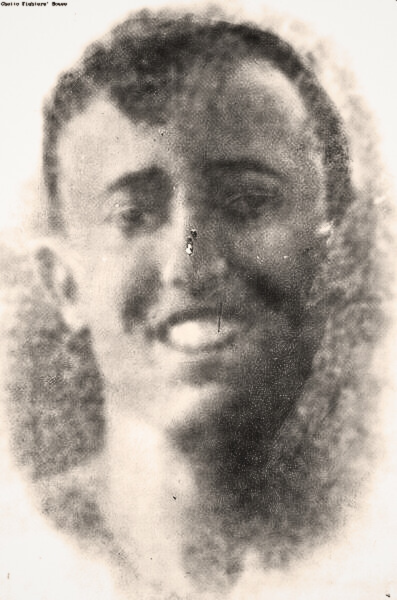Arie Wilner, alias Jurek (1917-1943)
A leader of the Ha-Shomer Ha-Tzair organization, one of the founders and commanders of the Jewish Combat Organization (ŻOB), a heroic liaison between ŻOB and the Home Army (AK) on the “Aryan side,” participant in the Warsaw Ghetto Uprising. A poet.
He was born in Warsaw in 1917 as Izrael Chaim Wilner. Known by the pseudonyms “Arie” and “Jurek.” He came from a wealthy family—his father owned a leather goods factory. He had two sisters, Halina and Gustawa, and a brother. He attended a private, Hebrew-language primary school, and later a state high school. He was an excellent student, but in 1937, due to escalating antisemitic attacks by students on their Jewish peers, he left school and continued his education externally. From a young age, he was interested in philosophy, wrote poetry, and loved music.
As a teenager, he joined the leftist Zionist youth organization Ha-Shomer Ha-Tzair. He was actively involved in the organization’s work and served as an instructor in the “Merhavya” battalion.

Arie Wilner | Ghetto Fighters’ House
After the outbreak of war in 1939, like many Jewish activists, he headed east—to Vilnius. In a letter to his sister Gustawa, he wrote that he was working for the local authorities as a graphic designer. When Germany attacked the Soviet Union in June 1941 and entered Lithuanian territory, the extermination of the local Jews began. Arie and a group of friends from Ha-Shomer found refuge in a Dominican convent near Vilnius. After several months—in the autumn of 1941—he returned to Warsaw to warn the Jews there about the mass executions being carried out in the Ponary Forest near Vilnius, where around 40,000 Jews were murdered.
Upon returning to the Warsaw Ghetto, he immediately threw himself into underground activity. He temporarily lived in the Ha-Shomer kibbutz at 23 Nalewki Street. He frequently left the ghetto as a liaison to regional Ha-Shomer branches. In early 1942, he began missions to organize resistance movements in Kraków and Częstochowa. In July 1942, shortly after the Nazis launched the great liquidation action of the Warsaw ghetto, a meeting took place between representatives of several youth organizations (Ha-Shomer, Dror, Bnei Akiva) during which the Jewish Combat Organization (ŻOB) was formed. Wilner attended this meeting on behalf of Ha-Shomer. Along with Marek Folman, he was assigned to operate outside the ghetto as a ŻOB representative tasked with establishing cooperation with the Home Army (AK) and the communist People’s Guard. He operated on the “Aryan side” under the alias Jerzy Borowski.
Despite his work outside the ghetto, Arie returned during the final week of the mass deportation operation. Despite heavy German and Jewish police surveillance at the walls, he managed to smuggle weapons into the ghetto.
In September 1942, the Great Deportation Action ended, during which about 250,000–280,000 Jews were murdered at the Treblinka extermination camp. ŻOB members convened to decide what to do next. The mood was filled with despair, helplessness, and rage. Some fighters, overcome with grief and a sense of defeat, suggested a collective act of honorable suicide—attacking the Germans with knives. However, Yitzhak Zuckerman and Arie Wilner urged the group to stay strong, reorganize, and prepare for true resistance. Historian Israel Gutman, who was present at that meeting, recalled Wilner’s words:
“Brothers, the best of us have already been torn up by the roots. Everything has been buried here, between these walls that have cut us off from the world—probably forever. Our blood has soaked into this earth, along with our dreams and hopes. […] We must disappear from the surface of the earth, hide, train, prepare; we will emerge from underground when we become a force capable of standing up to the enemy. We are still destined to live. But it will not be a normal life. Normal life is gone forever.”(Gutman I., Mered Hanetsurim)
Wilner managed to establish contact with the Home Army (AK). Initially, this did not translate into meaningful support for ŻOB. Later, thanks to his efforts, in November 1942, ŻOB was officially recognized by the Government Delegation and began receiving limited aid from the AK. Arie also collaborated with the communist People’s Guard to acquire weapons for the ghetto. Using the name “Jurek,” he emphasized the urgent need to arm the ŻOB fighters.
Gustawa Wilner, his sister, who survived the war, recalled in testimony for Yad Vashem that Arie constantly moved between the ghetto and the “Aryan side,” undertaking numerous dangerous missions—including transferring information and smuggling weapons:
“Sometimes we arranged to meet on the street. When he walked toward me, I was struck by how good he looked. A blond with blue eyes, slim, agile, in a sporty coat […] Hands in pockets, whistling a mazurka or kujawiak tune. In short, he didn’t give a hand at this cruel world.”
“He would often arrive exhausted, hungry, nearly at his limit. […] He didn’t sleep enough, had no place of his own. He stayed wherever he could, often in poor conditions. His nerves were always on edge. He once told me he even had to drink occasionally to get things done with some Poles—there was no other way to do business with them. He wasn’t used to that at all.”
On January 18, 1943, during the second deportation action, ŻOB launched its first armed resistance. Wilner commanded one of the fighting groups in the central part of the ghetto. The fighting lasted four days—several Nazis and dozens of Jewish fighters were killed. This was the first organized armed resistance in the Warsaw Ghetto, which shocked the occupiers and garnered wider support for ŻOB among ghetto residents. As a result, the Germans reduced the planned deportation of 8,000 Jews to around 5,000. Psychologically, this moment was a turning point—ghetto residents began to believe that armed resistance was possible.
“Arie described the Germans’ shock, their terror: ‘Do you know what it means not to fear the Germans?’ he shouted. ‘Not to give up, to fight, and to see their cowardice.’ He was full of enthusiasm. His only regret was that the ghetto still wasn’t adequately armed.”(Gustawa’s, testimony: Yad Vashem)
Friends on the other side of the wall repeatedly urged Arie to stay with them and not return to the ghetto. But he would always say:
“That is where I belong—wish me an honorable death instead.”
Thanks to Wilner’s efforts, ŻOB received from the Home Army (between August 1942 and March 1943) around 70 pistols, dozens of grenades, and explosives. A devastating blow came on March 6, 1943, when Arie was arrested in an apartment on Wspólna Street, on the other side of the wall. He was denounced by a Polish woman who had agreed to sell him weapons. Wilner’s arrest disrupted the cooperation between ŻOB and the AK regarding arms acquisition. Following his arrest, Arie was brutally tortured by the Gestapo for weeks—first in their torture chambers, then at Pawiak prison—but he did not betray anyone. His steadfastness impressed even his captors and greatly increased his standing among Jews in the ghetto.
When he was sent to a labor camp in Kawęczyn near Warsaw, he was miraculously rescued from German hands. At the apartment of Lutek Rotblat in the ghetto, he underwent surgery and was cared for during recovery by Lutek’s mother and Hela Rufeisen. He never fully regained his strength.
Besides his work as a ŻOB liaison, Wilner also helped his family escape the ghetto. He arranged apartments and documents on the other side and pleaded with them to flee. Thanks to him, his parents and sister Gustawa survived the war. Halina—the second sister—was also taken out of the ghetto with her husband but could not withstand the psychological stress of hiding and returned. She was deported and murdered.
After the March torture sessions, Arie remained in the ghetto until the uprising began. On April 19, 1943, the Germans surrounded the ghetto to carry out its final liquidation. Jewish fighters launched armed resistance, surprising the enemy and forcing German units to retreat twice during the first days. The insurgents then hid in bunkers, from which they organized ambushes and smuggled people out of the ghetto.
Arie Wilner was in the bunker at 18 Miła Street, which housed the ŻOB command and sheltered about 100 fighters and 200 civilians. As the Germans began setting fire to the ghetto, the situation became increasingly dire. The bunkers lacked air, and contact with the outside was lost. Wilner insisted on continuing to send people through tunnels, despite not hearing back from those who had already left.
“Whoever makes it through, will reach the other side. Even if only two out of ten survive—it’s better than dying here, slowly, from hunger and suffocation.”(Lubetkin C., In the Days of Destruction and Revolt)
On May 8, 1943, the Germans discovered the entrance to the bunker and filled it with gas. Panic ensued. According to Hela Rufeisen, who spoke to Tosia Altman after she escaped the bunker, Wilner cried out:
“Fighters, shoot yourselves! The last bullet is ours. We will not fall alive into German hands!”
Arie Wilner was the first to shoot himself. Others followed in a collective act of suicide. Around 100 ŻOB members died in the bunker; eight are believed to have survived, but none lived to see the end of the war.
In 1945, Arie Wilner was posthumously awarded the Silver Cross of the Virtuti Militari, 5th Class, by order of the Chief Command of the Polish Army.
Bibliography:
- Yad Vashem Archives: Gusta Wilner, Testimony 03/395
- Bernard M., Powstanie w getcie warszawskim, Warsaw 1963
- Cukierman I., A Surplus of Memory, Warsaw 2020
- Gutman I., Mered hanetsurim: Mordekhai Anilevits wemilhemet geto warsha, Jerusalem 2013
- Gutman I., Resistance: the Warsaw Ghetto uprising, Warsaw 1998
- Lubetkin C., In the Days of Destruction and Revolt, Warsaw 1999
- Rufeisen-Schupper H., Pożegnanie Miłej 18, Kraków 1996
- https://sprawiedliwi.org.pl/pl/historie-pomocy/historia-s-cecylii-marii-roszak [Accessed: May 19, 2025]

